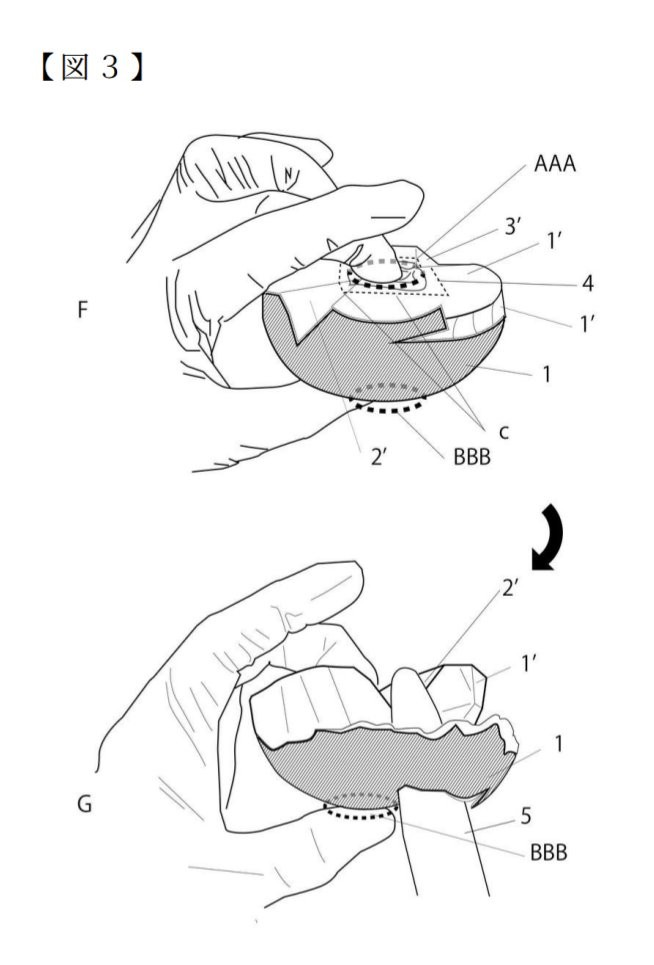
- Overview of the Patent Drawing
- Patent Insight 1: Hygienic Peeling Method for Food Preparation
- Patent Insight 2: Suitable for Ready-to-Eat Fruit Products
- Patent Insight 3: Automation Potential for Industrial Applications
- Patent Attorney’s Thoughts
- Keywords
- Application of the Technology: Museum Preservation Sector
Overview of the Patent Drawing
The illustrations depict a method for peeling an apple (1) designed to prevent direct contact between the fingers and the peeled surface. In Figure 3, the apple is held by the hand (F, G) while the peel (2′) is lifted away, leaving the fruit’s flesh exposed. The peeling action starts at specific areas (AAA, BBB) to ensure that the user’s fingers do not touch the freshly peeled portion. The top section (3′) indicates the starting point of the peeling process, while the dotted line (c) outlines the peeled area.
Patent Insight 1: Hygienic Peeling Method for Food Preparation
This apple peeling technique ensures that the fingers do not come into contact with the peeled surface, maintaining a higher level of hygiene during food preparation. This is particularly useful in environments where sanitary handling of food is crucial, such as in restaurants, catering services, or food processing facilities. It helps prevent contamination and maintains the quality of the peeled fruit.
Patent Insight 2: Suitable for Ready-to-Eat Fruit Products
The method is ideal for preparing apples intended for ready-to-eat fruit products, such as snack packs or fruit salads. By preventing finger contact with the peeled surface, the method ensures that the apple remains clean and appealing to consumers. It can also be applied to other types of fruits that require peeling while maintaining hygiene.
Patent Insight 3: Automation Potential for Industrial Applications
This peeling method could be adapted for automated systems in food processing, where machines can perform the peeling without touching the fruit’s surface. By replicating this technique mechanically, it would be possible to achieve consistent and hygienic peeling on a large scale, ensuring high standards of food safety.
Patent Attorney’s Thoughts
After reviewing the patent drawing for the “Apple Peeling Method to Prevent Finger Contact with Peeled Surface,” I was pleasantly surprised by its blend of practicality and insight into user behavior.
The concept of peeling an apple without touching the exposed fruit feels so intuitive — and yet, it took this clever design to make daily kitchen chores more pleasant and hygienic.
What struck me most was how the system addresses a small but often overlooked annoyance: the sticky, slippery surface that makes peeling apples messy.
By incorporating a mechanism that holds the fruit and guides the peeled layers away, it transforms a tedious activity into one that feels streamlined and almost elegant.
I could just picture myself effortlessly peeling apples for a pie or snack without worrying about getting sticky juice all over my hands.
It’s one of those inventions that prove smart thinking often starts with everyday frustrations.
Keywords
apple peeling, hygienic food preparation, no-touch peeling, food safety, ready-to-eat products, fruit processing, sanitary peeling method
Application of the Technology: Museum Preservation Sector
Purpose
Applying the concept of “avoiding direct finger contact” to the handling of fragile artifacts in museums and galleries, this system enables the non-contact manipulation and transfer of delicate cultural assets—such as ancient textiles, scrolls, ceramics, or paper artifacts—without risking contamination or damage.
System Components
- Contactless Lifting Tongs: Ultra-thin ends designed to gently scoop under fragile objects
- Adjustable Articulated Arm: Multi-jointed structure mimicking wrist motion for smooth control
- Micro-Vibration Absorption Pad: Gel-like surface to cushion fragile objects from minute tremors
- Clear Guard Sheet: Transparent shield that blocks humidity or breath during close inspection
- Elbow-Support Base: Stabilizes the arm to prevent unintentional pressure or shaking
Operational Flow
- Place elbows on the support base and equip the arm tool
- Use the lifting tongs to gently contact and lift the artifact
- Move the object using the articulated arm to the target area
- Place it on the display platform and cover with the clear guard sheet
- Return the arm to its default position, ensuring no direct contact occurred
Just like peeling an apple without touching the fruit inside, this idea allows conservators to handle history with the utmost care—without a single touch.
“Peel away the risks — handle history without a touch.”
A subtle, sophisticated application of dessert logic to world heritage.
Disclaimer: This content is an AI-generated reinterpretation based on a patent drawing.
It is provided for educational and cultural purposes only, and not as legal advice.



